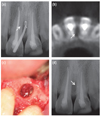1. Ida RD, Gutmann JL. Importance of anatomic variables in endodontic treatment outcomes: case report. Endod Dent Traumatol. 1995; 11:199–203.

2. Nair PN, Henry S, Cano V, Vera J. Microbial status of apical root canal system of human mandibular first molars with primary apical periodontitis after "one-visit" endodontic treatment. Oral Surg Oral Med Oral Pathol Oral Radiol Endod. 2005; 99:231–252.

3. Adorno CG, Yoshioka T, Suda H. Incidence of accessory canals in Japanese anterior maxillary teeth following root canal filling
ex vivo. Int Endod J. 2010; 43:370–376.

4. De Deus QD. Frequency, location, and direction of the lateral, secondary, and accessory canals. J Endod. 1975; 1:361–366.

5. Vertucci FJ. Root canal anatomy of the human permanent teeth. Oral Surg Oral Med Oral Path. 1984; 58:589–599.

6. Weine FS. The enigma of the lateral canal. Dent Clin North Am. 1984; 28:833–852.
7. Iqbal MK, Gartenberg J, Kratchman SI, Karabucak B, Bui B. The clinical significance and management of apical accessory canals in maxillary central incisors. J Am Dent Assoc. 2005; 136:331–335.

8. Barthel CR, Zimmer S, Trope M. Relationship of radiologic and histologic signs of inflammation in human root-filled teeth. J Endod. 2004; 30:75–79.

9. Ricucci D, Langeland K. Apical limit of root canal instrumentation and obturation, part 2. A histological study. Int Endod J. 1998; 31:394–409.

10. Ricucci D, Siqueira JF Jr. Fate of the tissue in lateral canals and apical ramifications in response to pathologic conditions and treatment procedures. J Endod. 2010; 36:1–15.

11. Dammaschke T, Witt M, Ott K, Schäfer E. Scanning electron microscopic investigation of incidence, location, and size of accessory foramina in primary and permanent molars. Quintessence Int. 2004; 35:699–705.
12. Wada M, Takase T, Nakanuma K, Arisue K, Naqahama F, Yamazaki M. Clinical study of refractory apical periodontitis treated by apicectomy. Part 1. Root canal morphology of resected apex. Int Endod J. 1998; 31:53–56.

13. Rubach WC, Mitchell DF. Periodontal disease, accessory canals and pulp pathosis. J Periodontol. 1965; 36:34–38.

14. Harrington GW. The perio-endo question: differential diagnosis. Dent Clin North Am. 1979; 23:673–690.
15. Friedman S, Abitbol S, Lawrence HP. Treatment outcome in endodontics: the Toronto Study. Phase 1: initial treatment. J Endod. 2003; 29:787–793.

16. Setzer FC, Boyer KR, Jeppson JR, Karabucak B, Kim S. Long-term prognosis of endodontically treated teeth: a retrospective analysis of preoperative factors in molars. J Endod. 2011; 37:21–25.

17. Siqueira JF Jr. Aetiology of root canal treatment failure: why well-treated teeth can fail. Int Endod J. 2001; 34:1–10.

18. Song M, Kim HC, Lee W, Kim E. Analysis of the cause of failure in nonsurgical endodontic treatment by microscopic inspection during endodontic microsurgery. J Endod. 2011; 37:1516–1519.

19. Arnold M, Ricucci D, Siqueira JF Jr. Infection in a complex network of apical ramifications as the cause of persistent apical periodontitis: a case report. J Endod. 2013; 39:1179–1184.

20. Aryanpour S, Van Nieuwenhuysen JP, D'Hoore W. Endodontic retreatment decisions: no consensus. Int Endod J. 2000; 33:208–218.

21. Bell GW. A study of suitability of referrals for periradicular surgery. Br Dent J. 1998; 184:183–186.

22. Reit C, Gröndahl HG. Management of periapical lesions in endodontically treated teeth. A study on clinical decision making. Swed Dent J. 1984; 8:1–7.
23. Kvist T, Reit C. The perceived benefit of endodontic retreatment. Int Endod J. 2002; 35:359–365.

24. Torabinejad M, Corr R, Handysides R, Shabahang S. Outcomes of nonsurgical retreatment and endodontic surgery: a systematic review. J Endod. 2009; 35:930–937.

25. Kim HH, Min JB, Hwang HK. Apical foramen morphology according to the length of merged canal at the apex. Restor Dent Endod. 2013; 38:26–30.

26. Kim S. Prognostic factors influencing clinical outcome of nonsurgical endodontic treatment. J Korean Acad Conserv Dent. 2010; 35:436–444.

27. Ponce EH, Vilar Fernández JA. The cemento-dentino-canal junction, the apical foramen, and the apical constriction: evaluation by optical microscopy. J Endod. 2003; 29:214–219.

28. Green D. A stereomicroscopic study of the root apices of 400 maxillary and mandibular anterior teeth. Oral Surg Oral Med Oral Pathol. 1956; 9:1224–1232.

29. Vieira AR, Siqueira JF Jr, Ricucci D, Lopes WS. Dentinal tubule infection as the cause of recurrent disease and late endodontic treatment failure: a case report. J Endod. 2012; 38:250–254.

30. Kim S, Kratchman S. Modern endodontic surgery concepts and practice: a review. J Endod. 2006; 32:601–623.







 PDF
PDF ePub
ePub Citation
Citation Print
Print



 XML Download
XML Download